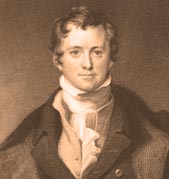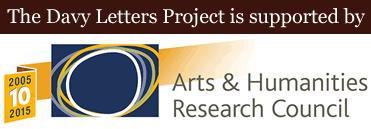Featured 
The Collected Letters of Sir Humphry Davy has been publishedThe Collected Letters of Sir Humphry Davy, a four-volume edition of the approximately 1,300 surviving letters of Sir Humphry Davy (1778-1829) and his immediate circle, has recently been published by Oxford University Press.
Davy was one of the most significant and famous figures in the scientific and literary culture of early-nineteenth-century Britain, Europe, and America. Davy's scientific accomplishments were varied and numerous, including conducting pioneering research into the physiological effects of nitrous oxide (laughing gas); isolating potassium, calcium, and several other metals; inventing a miners' safety lamp (the bicentenary of which was celebrated in 2015); developing the electrochemical protection of the copper sheeting of Royal Navy vessels; conserving the Herculaneum papyri; writing an influential text on agricultural chemistry; and seeking to improve the quality of optical glass. But Davy's endeavours were not merely limited to science: he was also a poet and moved in the same literary circles as Lord Byron, Samuel Taylor Coleridge, Robert Southey, and William Wordsworth.
In spite of Davy's significance and fame, very few of his letters have appeared in print edited to modern standards; fewer than 250 have been published even in the form of quoted extracts or, expurgated and unannotated, in Victorian volumes. The Collected Letters therefore increases the number of published letters written by Davy approximately fivefold. The edition provides complete, fully annotated texts, making Davy's scientific terminology more intelligible to contemporary readers and expanding our knowledge of the scientific and literary networks of which he was part. It features previously unpublished letters to such notable correspondents as André-Marie Ampère, Sir Joseph Banks, Thomas Beddoes, William Buckland, Samuel Taylor Coleridge, Georges Cuvier, John Dalton, Davies Giddy/Gilbert, William Godwin, Sir John Herschel, Lord Holland, Alexander von Humboldt, Lord Liverpool, Gideon Mantell, Alexander Marcet, John Murray, Hans Christian Oersted, Sir Robert Peel, Sir Stamford Raffles, August Wilhelm Schlegel, James Edward Smith, Mary Somerville, Henry Fox Talbot, James and Gregory Watt, Josiah and Thomas Wedgwood, and William Whewell.
Throughout the edition, letters are presented in chronological order, each letter being assigned its own number. All letters are transcribed in full and editorial intervention in the text has been kept to a minimum. Davy's original spelling (and misspelling), grammar, and punctuation have been retained. The edition also includes a detailed General Introduction, a List of Letters, Biographies of Correspondents, a Chemical and Technical Glossary, a Bibliography of Davy's Manuscript Notebooks and Publications, a General Bibliography, and a comprehensive Index.
The Collected Letters of Sir Humphry Davy, edited by Tim Fulford and Sharon Ruston, advisory editors Jan Golinski, Frank A. J. L. James, and David Knight, assisted by Andrew Lacey, 4 vols (Oxford: Oxford University Press, 2020)
Order online at www.oup.com/academic with promo code AAFLYG6 to save 30%
The Davy Notebooks Project has launchedThe Davy Notebooks Project has launched - Help us to transcribe the manuscript notebooks of Sir Humphry Davy
The Davy Notebooks Project has just launched on Zooniverse, the world’s largest and most popular platform for people-powered research.
Sir Humphry Davy (1778-1829) was one of the most significant and famous figures in the scientific and literary culture of early nineteenth-century Britain, Europe, and America. Davy’s scientific accomplishments include: conducting pioneering research into the physiological effects of nitrous oxide (often called ‘laughing gas’); isolating seven chemical elements (magnesium, calcium, potassium, sodium, strontium, barium, and boron) and establishing the elemental status of chlorine and iodine; inventing a miners’ safety lamp; developing the electrochemical protection of the copper sheeting of Royal Navy vessels; conserving the Herculaneum papyri; and writing an influential text on agricultural chemistry. Davy was also a poet, moving in the same literary circles as Lord Byron, Samuel Taylor Coleridge, Robert Southey, and William Wordsworth.
The notebooks selected for this pilot run of the Davy Notebooks Project reveal how Davy’s mind worked and how his thinking developed. Containing details of his scientific experiments, poetry, geological observations, travel accounts, and personal philosophy, Davy's notebooks present us with a wide range of fascinating insights. Many of the pages of these notebooks have never been transcribed before. By transcribing these notebooks, we will find out more about the young Davy, his life, and the cultures and networks of which he was part.
All you need to contribute is a Zooniverse account - sign up today at https://www.zooniverse.org/projects/humphrydavy/davy-notebooks-project. If you have any questions, please send them to [email protected], or post them on our Zooniverse Talk boards. Project updates will be posted to our Twitter account: https://twitter.com/davynotebooks
More Items ..Home
This website has been funded by the British Academy, the Wellcome Trust, the British Society for the History of Science, and the Society for the History of Alchemy and Chemistry. It is the first stage in the publication of the first ever edition of the Collected Letters of Humphry Davy and his Circle, edited by a team of Davy scholars.
These letters document Davy’s work on electrochemistry and electromagnetism, mineralogy and geology, and his collaborations with other chemists such as J. G. Children and W. H. Pepys. They illuminate the controversy that initially followed his identification of chlorine as an element, and his experiments on fluorine and iodine. The experimental work leading to the development of the safety lamp and the subsequent dispute concerning credit for that invention are also covered. The Collected Letters of Davy and his Circle promises to reveal much about Davy himself, his wife and brother, and the milieu in which they lived.
We present here transcriptions of Davy's letters, to be published in 2020 as The Collected Letters of Sir Humphry Davy (Oxford University Press). Definitive transcriptions with full annotation will be found in the published edition.




